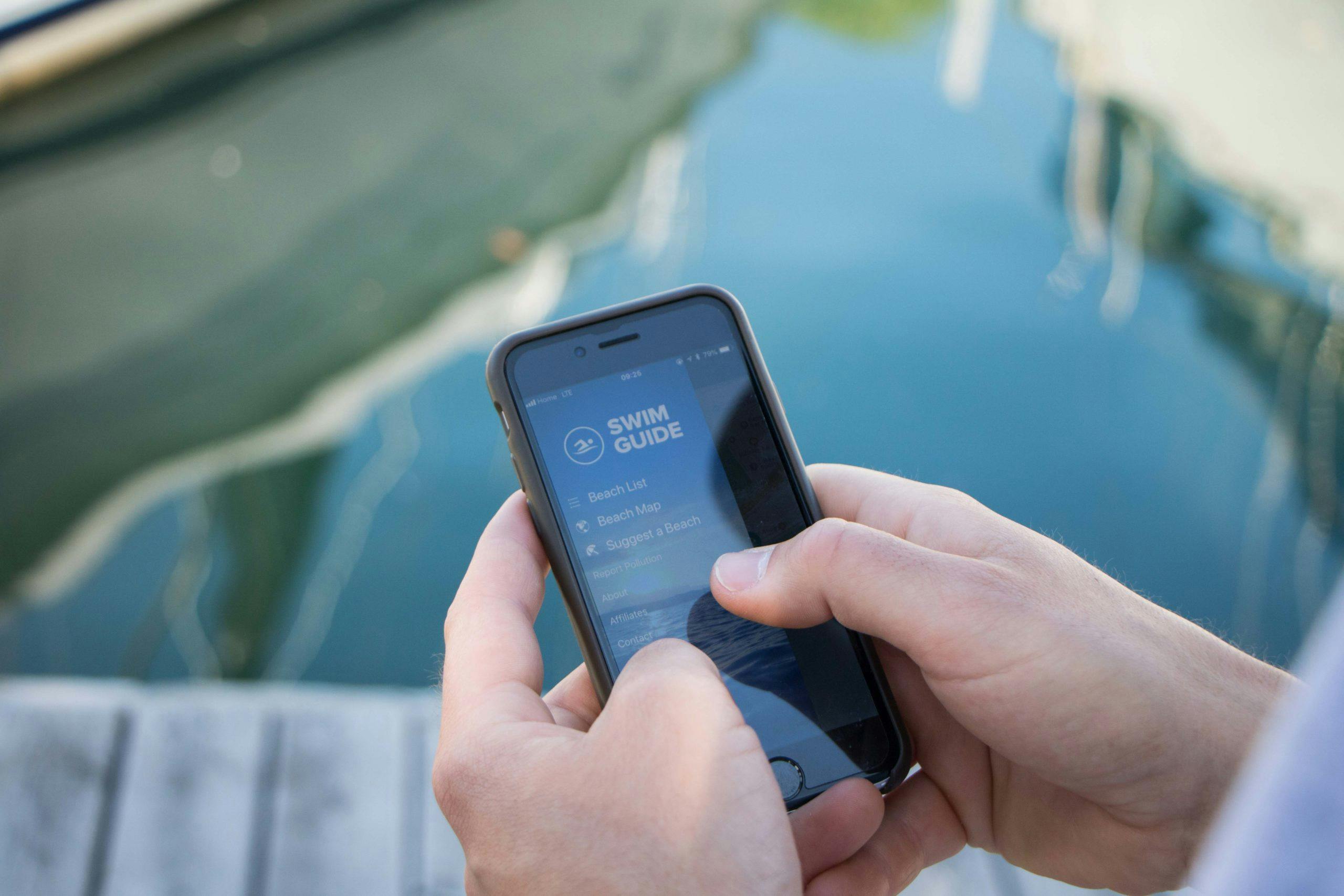Ten years ago, Swim Guide was launched to answer the question, “Where can I go swimming?” For the past decade, our small but dedicated team has been connecting you to your local waters by providing reliable facts and figures about beach water quality.
Swim Guide is the most popular beach information service in the world, made possible by our premier partner RBC’s ‘Tech for Nature’ program and the RBC foundation.
In the five years before Swim Guide’s creation, Lake Ontario Waterkeeper, now Swim Drink Fish, tracked which beaches were open or posted and compiled reports with water quality data. Daily, we called hotlines and recorded beach information before it disappeared permanently.
But how did Swim Guide grow from its modest roots into what it is today?
As of 2021, our 100 affiliates help us deliver free up-to-date water quality information for over 8,000 beaches, lakes, rivers, and swimming holes in 11 countries, for over 4 million users.
Year by year, here is the story of how Swim Guide got to where it is now.
2011
In 2011, Lake Ontario Waterkeeper received funding from RBC to create a free app listing recent water quality results for beaches on Lake Ontario. Built entirely by staff and volunteers, the app demonstrated how technology could connect people with water and foster a new generation of water leaders.
Within only weeks of its launch, Swim Guide had more than 10,000 users. During the first summer season, Swim Guide was collaborating with 90 different sources that monitored 1,700 beaches daily.
Swim Guide even expanded to join forces with the Waterkeeper Alliance, a global network that works for a swimmable, drinkable, fishable future. By the end of the year, Swim Guide was including water quality data from North Saskatchewan Riverkeeper and Miami Waterkeeper.
2012
By 2012, Swim Guide spread to to major Canadian and American cities, with dozens of affiliate organizations contributing data to the platform including: Mobile Bay, AL, California, Florida, Charleston, SC, Puget Soundkeeper, WA, Connecticut, Greater Boston, MA, Chesapeake Bay MD, NYC, Shenandoah River Valley, VA/WV.
Ottawa Riverkeeper joined this year, bringing bilingualism to Swim Guide with a watershed that encompassed both Ontario and Quebec. Implementing French on the platform was a huge step in making Swim Guide a truly national platform. Over the years, Ottawa Riverkeeper advocated for more frequent municipal testing and led a public right to know campaign to post CSOs so water users could make informed decisions.
Swim Guide also launched its second version of the app this year.
2013
In 2013, Swim Guide launched its new website, with a more interactive map, featuring popular local beaches, pollution reporting, beach photos, and more. Assateague Coast and West/Rhode Riverkeeper also joined the platform.
2014
New regions were added to Swim Guide in 2014, including Baja Peninsula, Mexico, Surfrider Foundation’s Vancouver Island Chapter, Coosa Riverkeeper, AL, and New Zealand (launched by Pulse Energy).
2015
2015 saw two huge milestones for Swim Guide. First, Swim Guide’s Affiliate Program was introduced to help collaboratively sample water and share data on a larger scale than ever before. Second, Swim Guide’s users reached the 500,000 mark, a record-breaking high.
Snake River Waterkeeper, Satilla Riverkeeper, and +Pool also joined Swim Guide this year.
2016
In 2016, Swim Guide partnered with the Watermark project, another Swim Drink Fish initiative, to share the memories of people’s connections to specific waterbodies. Swim Guide also launched another new and improved version of its website, with blogs about beach life and environmental issues, weather, a larger map, and a faster, cleaner design.
Swim Guide Also welcomed Buffalo Niagara Riverkeeper, Yuba River Waterkeeper, Manitoba, and Petitcodiac River watershed to the platform, as Pulse Energy sponsored Swim Guide in New Zealand for the third year in a row.
2017
2017 was a huge year for Swim Guide. The platform reached 1 million users, developed an open data standard for recreational water quality, and launched a new Android version of the Swim Guide App.
Swim Guide also received sponsorship from Ace Hill beer and IDEXX Laboratories, and Swim Drink Fish received the Canadian Immunology Research Association (CIRA) Community Investment Program Grant.
In 2017, Swim Guide also welcomed new affiliates, Salmon Drift Creek Watershed council, Friends of the Cheat, Chattahoochee River Warden, Chester River Association, and Surfrider Foundation Rincón aboard. Australia also joined Swim Guide with recreational water quality information for the Australian Capital Territory.
2018
In just a year, Swim Guide users doubled from 1 million in 2017 to 2 million in 2018. Surfrider Foundation Kauai Chapter and White River Waterkeeper, AR joined as new affiliates.
2019
2019 saw the automation of New Zealand’s data from the region’s 700 beaches, as well as new affiliates Lake Victoria Waterkeeper, Kenya and four new affiliates in North Carolina: MountainTrue’s Green and Broad Riverkeepers, Haw River Assembly, and Catawba Riverkeeper Alliance.
2020
As the COVID-19 pandemic forced beaches to close in the US and Canada and suspended water quality monitoring in some regions, Swim Guide kept beachgoers up to date with the latest information about recreational waters during 2020.
In 2020, Swim Drink Fish also became Blue Flag Canada’s national operator, advising beach and marina operators on how to receive and keep their Blue Flag certification.
This is also the year that Swim Guide reached 7.5 million users.
New affiliates were Waccamaw Riverkeeper, Surfrider – Broward County Chapter and San Diego, Cape Fear River Watch, Arundel River Federation, St Mary’s Riverkeeper, Yadkin Riverkeeper, and WWALS Watershed Coalition.
2021
In 2021, Swim Guide’s affiliates grew to over 100, and we reached the impressive milestone of 10,000 samples taken per month! Our site traffic continued to increase, reaching 21 million page views.
We are excited to see where the future takes us.
As Swim Guide continues to grow, our team continues to be grateful to all of the sponsors, volunteers, and beach-goers that make our success possible.

